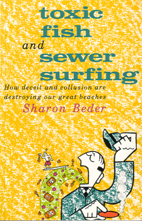
by Sharon Beder
first published by Allen & Unwin, Sydney, 1989
Introduction
Sewers seaward
Toothless watchdog
Toxic fish
Sewer-side surfing
Public relations battle
Events of 1989
Beyond Sydney
Conclusion
Bibliography
In September 1989 Camp, Dresser & McKee presented a draft of their review of Sydney’s Beach Protection Programme to the government. The review confirmed that the extended outfalls would not solve the beach pollution problem. They pointed out that even after the extended outfalls are completed, ‘contact with, or direct ingestion of, small grease particles may present an acute public health hazard’.
The Board’s new Trade Waste Policy also drew heavy criticism. The Board would have to increase their charges by about ten times to get industry to reduce their waste streams. They also noted that the Board did not seem to have even the most essential information necessary to work out appropriate limits for industrial waste. Standards for acceptance of toxic waste into the sewers were considerably less than those imposed on comparable industries in the United States.
The review recommended that in the short term, treatment at the main outfalls be upgraded by adding chemicals and that sludge dumping into the ocean be ceased. This would improve the process to more like what primary treatment is supposed to be. If that wasn’t good enough the primary treatment could be further enhanced later. They said secondary treatment may not be required and a ‘decision may therefore be deferred for more than a decade’. (And no doubt it will be deemed to be unnecessary if public protests have died down in ten years or so!)
Camp, Dresser & McKee admitted that secondary treatment was better at removing suspended solids, grease, toxic chemicals and viruses. They estimated it would cost $459 million for Malabar and North Head. (At present the Board is raising $400 million in five years from its $80 environment levy and this could be increased to $800 million if industry paid a fair share.) However, the public was told that they would have to pay an extra $300 each year in rates if the recommendations were implemented. This included the cost of renewing Sydney’s aging sewer system and the elimination of sewer overflows ($2.5 billion). Almost immediately the government an- nounced that the $300 per year was too much and that they would have to shelve the long-term recommendations of the report.
In 1936 ‘independent’ engineers similarly recommended that sewage be treated at each outfall with coarse screens in the short term and full primary treatment in the long term. Now, more than 50 years later, another set of engineers is again recommending that the Board treat the sewage to full primary standard in the short term and consider secondary treatment in the long term. Given past experience, unless Sydney-siders push for secondary treatment now, Sydney beaches will still be dogged by primary-treated sewage halfway through the next century.